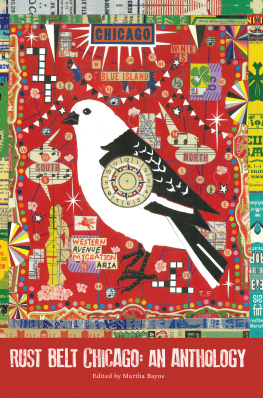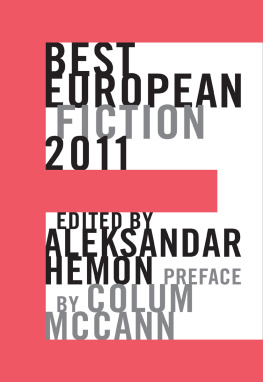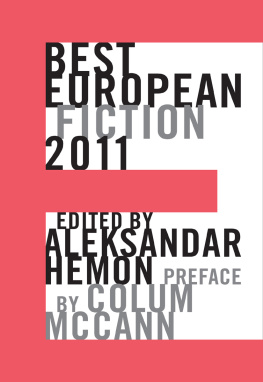ABOUT THE AUTHOR
Mark Athitakis has written on books for many publications, including the New York Times , Washington Post , Minneapolis Star-Tribune , Barnes and Noble Review , and Belt Magazine , which publishes his Reading the Midwest column. He lives in Arizona.
THE NEW MIDWEST
A Guide to Contemporary Fiction
of the Great Lakes,
Great Plains, and Rust Belt
Mark Athitakis
Copyright 2016 Mark Athitakis
All rights reserved. This book or any portion thereof may not be reproduced or used in any manner whatsoever without the express written permission of the publisher except for the use of brief quotations in a book review.
First edition 2016
ISBN: 978-0-9977742-8-3
Belt Publishing
1667 E. 40th Street #1G1
Cleveland, Ohio 44120
www.beltmag.com
Book design by Meredith Pangrace
Cover by David Wilson

jINTRODUCTION:
The Past and Present of the Fiction of the Midwest
(Wherever That Is)
A few years ago I noticed something about my favorite works of contemporary fiction set in the Midwest: they were all set in the past. Jeffrey Eugenides Middlesex (2002) is a sweeping tale that mostly takes place in 1960s Detroit. Marilynne Robinsons Iowa-set novels) Gilead (2004), Home (2008), and Lila (2014)explore the state in the middle of the twentieth century. Ward Justs An Unfinished Season (2004) spotlights upper-class journalists and lower-class laborers in 1950s Chicago. Celeste Ngs Everything I Never Told You (2014) is set in 1970s Ohio. Chris Wares Jimmy Corrigan: The Smartest Kid on Earth (2000) is thick with flashbacks to Chicagos 1893 Columbian Expositionan event that, thanks to Erik Larsons 2003 blockbuster historical true-crime tale, The Devil in the White City , seems to be the only Midwestern story people find interesting en masse besides cop and hospital dramas. And on and on.
This struck me as a problem. Why were writers considering the Midwest as a place where things happened , but no longer did? Earlier generations of writers didnt behave this way. The canonical Midwest writersWilla Cather, Theodore Dreiser, Saul Bellow, Ernest Hemingway, Richard Wrightall wrote about Illinois, Michigan, Nebraska, and Ohio in their moment, using their fiction for journalistic, way-we-live-now purposes at a transformative moment for the region. Through the first half of the twentieth century and much of the postwar period, the American economy shifted from agricultural to urban, and the migration of blacks from the South and immigrants from Europe made the Midwest an industrial powerhouse, and a rich breeding ground for social conflict to boot. Sinclair Lewis satirized that moment; Wright condemned the racism that accompanied it; Bellow celebrated transcending it. But as the twenty-first century approachedand as the Midwest lived in a new moment, one when its manufacturing might continued a steady decline that began in the 1970s and 1980ssome of the most prominent novelists and short-story writers werent keeping up. Indeed, they seemed to gaze mostly backward at the region. In 1966, Robert Coover, a writer as eager as any postwar American novelist to challenge literary orthodoxy, published The Origin of the Brunists, an epic novel about an Illinois mine explosion hardly a decade past. In 2014, he delivered an epic sequel about what happened... five days later.
Not every Midwestern writer is caught in this time warp. Aleksandar Hemon writes about contemporary Chicago with a seriocomic grace. Gillian Flynn isnt just a master of page-turning plot twists, but a savvy thinker about the intersection of the Midwest and South in todays Missouri bootheel. Bonnie Jo Campbell and Stewart O Nan have written sharp fiction about middle-class survivors in present-day Michigan and Pennsylvania. Jonathan Franzen is much-mocked for (among many, many other things) being forever conflicted about whether Midwestern values are a boon or bane, but he considers those values as theyre being lived now. In the past decade or so, stories about the economic decline of the Rust Belt and Detroit have stoked novels like Philipp Meyers American Rust (2009) and Angela Flournoys The Turner House (2015).
Even those books, though, are often concerned with the pastthat is, with whats been lost since the factories closed, after the verities of Midwestern values have eroded, once the promises of the region as one that welcomed immigrants and provided stability for blacks and Hispanics has crumbled. If theyre not nostalgic for the past, they often lament whats been lost in the present.
But if todays Midwestern writers arent on top of the news the way their precursors were, they arent engaging in empty nostalgia either. Something more dialectical is going on: just as the books set in the present day are reckoning with the past, the books set in the past are also arguing with the present. Midwestern fiction today is a living manifestation of the tension between the regions old idealism and present-day reality. Robinson, Eugenides, Ng, and Justand Jayne Anne Phillips and many more well get tohave used their novels to voice themes about race, sexuality, work, faith and more that they wouldnt have had the freedom to in the time when their books are set. Thats a risky strategy that doesnt always make for persuasive fiction: implanting contemporary values upon the stories of the past is a tricky business if realism is your game. But I think Midwestern fiction is stronger for the number of writers whove risen to the task. The better writers on that front, such as Flynn, Ware, and Dinaw Mengestu, exploit the surfaces of the homey Midwest tale to smuggle in a more provocative or contemporary perspective. Contemporary American fiction is often dismissed as dealing in safe and gentle domestic family dramas set in white and upper-middle-class milieus. Thats not whats happening in these books, though.
So why do we assume it does? Why does that reflex to see the Midwest as narrow and retrograde kick in so readily, years after the region has transformed from what it used to be?
O ne answer, in the form of a true story about the Midwest and baseball:
October 26, 2005. The Chicago White Sox are facing the Houston Astros in Game Four of the World Series, poised to win their first championship in eighty-eight years. At the bottom of the ninth inning, with the Sox one out away from a 1-0 victory and series sweep, Foxs live coverage in Houston cuts for a moment to Chicago and Jimbos, a South Side sports bar full of cheering, boozy Sox fans. Amid the revelry, broadcaster Joe Buck solemnly puts the approaching victory into context.
What does this mean to the South Side? he asks, then offers a rough demographic sketch of the area. A collection of neighborhoods like Beverly, Mount Greenwood, Hyde Park, Back-of-the-Yards, Canaryville, Bridgeport. Irish neighborhoods, Italian neighborhoods. Polish, Lithuanian. Firemen, policemen, school teachers, stockyard workers.
Stockyard workers.
Those two words say a lotmore than Buck likely intended. Like the Soxs championship drought, Bucks read on the city was a few decades out of date as well. As the Chicago journalist Alex Kotlowitz bemusedly noted in Fast Company after tuning in to the game, the last stockyard in the city closed in 1971. There was no reason why facts should get in the way of a good story on the verge of the White Soxs triumph, though; whether Buck studied his history or not, he was embracing a mythology that has long been connected the South Sideand to an extent, the greater Midwest. Its a romantic vision of a singularly hardworking place that welcomes floods of European immigrants and prides itself on the hard labor of construction, manufacturing, and meatpacking. If nobody can recite Carl Sandbergs 1914 poem Chicago anymore, they at least know its the one that calls it the City of the Big Shoulders and the stacker of wheat and Hog Butcher for the World. Thats the myth: masculine, vibrant, busy.
Next page











